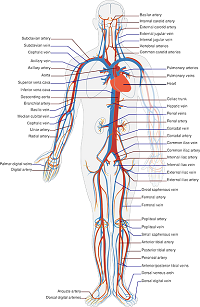![]()
 Vascular disease is typically caused by atherosclerosis (hardening of the arteries) that occurs from a thickening of the artery linings from atheroma (plaques) or fatty deposits.
Vascular disease is typically caused by atherosclerosis (hardening of the arteries) that occurs from a thickening of the artery linings from atheroma (plaques) or fatty deposits.
The arteries are the blood vessels that perform the function of supplying nutrients, oxygen and blood to different parts of the body that comes from the organ known as the heart. Hardened or narrow arteries make it a difficult task for blood flow.
The parts of the human body that are affected by vascular disease, suffer from the consequences related to tissue damage, poor function, inadequate blood-supply and in some cases even tissue death.
The symptoms related to vascular diseases are different and will depend on where the disease is situated. Vascular disease commonly affects arteries in the legs, brain and heart, but can also affect organs such as the eyes and the kidneys.
Cardiovascular Disease – The Heart
Mild degrees of atherosclerosis will not cause symptoms, but more severe conditions are often associated with chest pains when the individual exercises or exerts themselves, the pain settles after rest.
When a heart attack occurs, the individual will feel tight or heavy chest pain that can also be experienced in the left arm or the throat. Pain that does not subside after 20 minutes means the individual should immediately seek medical attention.
Cerebrovascular Disease
Arteries that have narrowed in the area of the brain can often become blocked (cerebral thrombosis) by clots. These clots can develop in the carotid arteries in the area of the neck that supplies the blood to the brain.
Alternatively, the smaller arteries that are diseased can rupture and then bleed into the area of the brain, both these cases cause damage to the area of the brain and are known as a stroke.
Strokes usually produce very sudden symptoms. These symptoms usually include issues with coordination, balance and vision, difficulties in swallowing, speech difficulties, paralysis on 1 side of the face and paralysis. The symptoms related to this vascular disease that causes a stroke is explained by the FAST pneumonic:
F – Stands for face. The patient will be asked to smile to observe if both the right and left part of the face moves symmetrically and normally.
A – Stands for arms. The patient will be asked to move both arms. This test is to observe whether one arm may be weaker when compared to the other.
S – Stands for speech, this test are to check if the patient’s speech has become slurred and do the words that come out make any sense?
T – Stands for telephone, this warning are suggested to phone for help if any other above symptoms are recognized.
Peripheral Vascular Disease –The Legs
Atherosclerosis which is a type of vascular disease of the legs begins with cramping pains in the muscles of the legs on exertion. This pain usually subsides after resting for a few minutes. The symptoms of this pain are caused from the muscles that do not receive enough blood.
The more common symptoms of peripheral-vascular disease will be pain experienced in the hips, thighs or calves. This pain occurs when the individual is climbing stairs or walking and then subsides when the person rests. The blocked or narrowed arteries are unable to supply enough blood and the muscles become deprived of nutrients and oxygen.
This type of pain is known as intermittent claudication which means that it comes-and-goes. The pain experienced usually consists of cramping, a dull pain, tiredness, tightness and heaviness of the muscles in the legs.
When the blood vessels in the legs have become completely blocked, then pains in the legs experienced at night is a common occurrence.
The only way to relieve this type of pain would be to hang the feet down in order to relieve this pain. This causes passive blood flow into the distal parts of the leg or legs. Other symptoms associated with peripheral vascular disease include:
•Impotence
•Pain in the area of the buttocks
•Weakness, tingling or numbness in the area of the legs
•One or the other or both the feet or legs feels cold to the touch or can change color to a dark reddish, bluish or pale
•Hair loss on the area of the legs
•An aching or burning pain experienced in the toes or feet while resting
•A sore or sores on the feet or legs that are unable to heal
The Risk Factors Of Vascular Diseases
Vascular diseases can affect a variety of people. It can begin from the young age of 20 and will generally advance and increase with age. The exact causes are typically unknown, however there are many risk factors that will accelerate the development of these fatty deposits or plaque inside the arteries:
•Lack of or little regular exercise
•Smoking
•An unhealthy diet
•Diabetes
•High blood pressure
•High cholesterol levels


 OneCareNow is a general weblog that was created by several writers with a specific goal in mind: To offer one place that covers important topics which people really care about.
OneCareNow is a general weblog that was created by several writers with a specific goal in mind: To offer one place that covers important topics which people really care about.![Back Pain Breakthrough by Palmer & Dr. Young [2024 Review]](https://www.onecarenow.org/wp-content/uploads/2021/02/Back-Pain-Breakthrough-Young-Amy-50x50.png)
![Vincent’s Midas Manifestation System Review [Updated 2024]](https://www.onecarenow.org/wp-content/uploads/2021/02/Midas-Manifestation-50x50.png)
![The NEW Happiness Code by David [Updated 2024 Review]](https://www.onecarenow.org/wp-content/uploads/2021/01/The-NEW-Happiness-Code-50x50.png)
![Michael Christianson’s Manifestation Sigil Review [2024]](https://www.onecarenow.org/wp-content/uploads/2021/01/Manifestation-Sigil-50x50.png)
